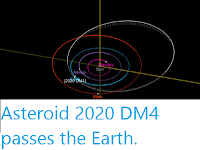Asteroid 2020 JN passed by the Earth at a distance of about 249 200
km (0.65 times the average distance between the Earth and the Moon, or
0.17% of the distance between the Earth and the Sun), slightly after 3.20 am
GMT on Tuesday 5 May 2020. There was no danger of
the asteroid hitting us, though were it to do so it would not have
presented a significant threat. 2020 JN has an estimated
equivalent
diameter of 6-20 m (i.e. it is estimated that a spherical object
with
the same volume would be 6-20 m in diameter), and an object of this
size
would be expected to explode in
an airburst (an explosion caused by superheating from friction with the
Earth's atmosphere, which is greater than that caused by simply
falling, due to the orbital momentum of the asteroid) in the atmosphere
between 37 and 20 km above the ground, with only fragmentary material
reaching the Earth's surface.
60 second image of 2020 GN2 taken with the Elena Planetwave 17" Telescope
at Ceccano
in Italy on 4 May 2020. The asteroid is the small point at the
centre of the image, indicated by the white arrow, the longer lines are
stars, their elongation being
caused by the telescope tracking the asteroid over the length of the
exposure. The line across the bottom right section of the image is a
satellite that moved across the field of vision during the exposure. Gianluca Masi/Virtual Telescope.
2020 JN was discovered on 4 May 2020 (the day before its closest encounter with the Earth) by the University of Hawaii's PANSTARRS telescope. The
designation 2020 JN implies that it was the 13th asteroid (asteroid N)
discovered in the first half of May 2020 (period 2020 J).
2020 JN has a 468 day (1.28 year) orbital period, with an elliptical
orbit tilted at
an angle of 2.78° to the plain of the Solar System which takes in to
0.40 AU from the Sun (40% of the distance at which the Earth orbits the
Sun, and slightly outside the orbit of the planet Mercury) and out to 1.96 AU (196% of the distance at which the Earth orbits
the sun and further from the Sun than the planet Mars). It is therefore classed as
an Apollo Group Asteroid (an asteroid that is on average further from the Sun
than the Earth, but which does get closer).
2020 JN also
has frequent close encounters with the planets Mercury, which it last passed in November 1979, and is next predicted to
pass in June 2023, Venus, which it last passed in August 2006, and is next predicted to
pass on 27 May this year (2020), and Mars, which it last passed in April 1997. Asteroids
which make close passes to multiple planets are considered to be in
unstable orbits, and are often eventually knocked out of these orbits by
these encounters, either being knocked onto a new, more stable orbit,
dropped into the Sun, knocked out of the Solar System or occasionally
colliding with a planet.
See also...
Follow Sciency Thoughts on Facebook.








